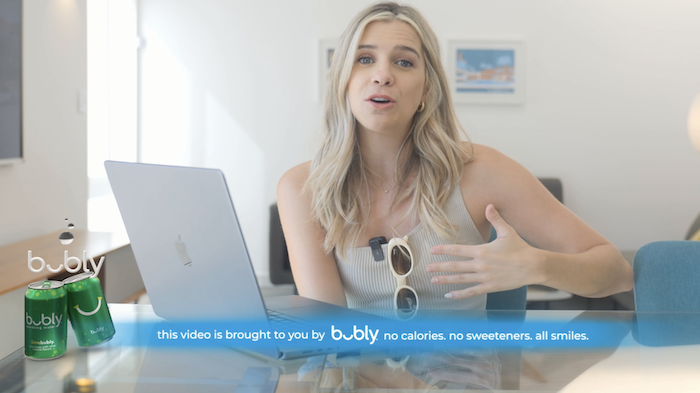From AI powered brand placement, the growth of shoppable video ads and hyper-targeted audience segmentation, artificial intelligence tools are reshaping the video advertising landscape.
I get asked the question often, “What does an agency need to know about AI”? Most of the time, people are searching for tools to use to make themselves more efficient, but that is only part of the story.
Agencies need to know that AI is a tool which can improve efficiency and increase creativity when used right. As the saying goes, which has widely been adopted, “AI is not going to take your job, but the person who uses AI most certainly will”.
From my point of view, you need to know what’s new, what’s working and most importantly, why you should care. Then you’re informed enough to decide on what to do as an agency that supports brands in any location.
I’d specifically like to focus on AI in video advertising, because there are some significant developments there that you can’t afford to ignore. The biggest driver of these advancements is that we are not listening to the clear signal from our viewers – that they skip the ads we show them at an alarming rate.
The rapid advancements in AI technology are reshaping the video advertising landscape, offering new opportunities for brands to connect with their target audiences in more meaningful and effective ways.
WHAT’S NEW
The growth of shoppable video ads
The rise of connected TV (CTV) has opened a whole new world of possibilities for video advertising. With more consumers shifting their viewing habits to ad-supported content on CTV platforms like Hulu and Roku, brands now have access to a massive and highly engaged audience.
What sets CTV apart is the ability to deliver shoppable video ads that seamlessly blend content and commerce. The idea of these ads is not new, but the technology to enable them is.
These interactive ads feature clickable elements, such as links or QR codes, that allow viewers to explore products or add them directly to their cart without interrupting their viewing experience. These elements are beginning to be dynamically targeted to the audience who sees them. What’s more, these solutions can work across platform as more viewers are consuming this content on mobile and connected TVs than they are on a desktop.
This changes the way the audience interacts with the content dramatically. In the past month alone, major CTV platforms have significantly expanded their shoppable ad formats, introducing game-changing features such as in-ad product carousels and advanced targeting options based on rich viewer data.
AI-powered brand placement in video
Picture this: your brand seamlessly integrated into the content people love, without disrupting their viewing experience. That’s the magic of AI-powered brand placement. Innovative solutions like Regenerative Fusion™ (from Rembrand) enable branded objects, such as logos, products, or even virtual billboards, to be inserted into video content during the post-production process.
This means brands can achieve prominent visibility within the content itself, without the need for traditional ad breaks. These models were expensive or required long lead times in the past, but the emergence and expansion of AI tools allows advertisers to execute these insertions easily and quickly while maintaining a very natural feel to them.
This creates a non-intrusive and immersive advertising experience. This approach offers a win-win-win scenario. Creators can focus on crafting compelling content without worrying about explicit brand integrations that can appear non-authentic or impede the development of their content.
Advertisers can select the most suitable creators and content that align with their brand values and target audience, even after the content has been produced and execute in a shorter window.
Viewers can enjoy their favourite content uninterrupted, while still being exposed to brand messages in a subtle and organic way.
This has proven effective at traditional metrics like awareness and recall, but also in brand favorability by aligning the brands with the content and creators that audiences love.
The power of AI-powered brand placement lies in its ability to generate positive brand associations, drive engagement, and leave a lasting impact on the audience. (Full disclosure: I’m the CMO at Rembrand, a company at the forefront of this exciting technology. If you’d like to explore how AI-powered brand placement can elevate your video advertising strategy, I’d be delighted to hop on a call and show you more.)

WHAT’S WORKING?
Hyper-targeted audience segmentation
One of the biggest advantages of AI in video advertising is its ability to analyze vast amounts of data and identify highly specific audience segments. Gone are the days of broad demographic targeting, replaced with a fine tooth, hand-to-hand combat approach that is enabled by technology.
With AI-powered segmentation, Fortune 1000 brands can now target their ads based on a wide range of parameters, including niche interests, behavioural patterns, purchase history, and even predicted future actions. Plus, they can do so quickly and easily by allowing the algorithms to hypothesise and implement rather than crunching the data themselves.
By leveraging machine learning algorithms, brands can uncover hidden audience insights and create highly personalised ad experiences that resonate with each individual viewer.
This level of hyper-targeting ensures ads reach the people who are most likely to engage and convert, maximising the effectiveness of every advertising dollar spent.
AI-powered segmentation also enables brands to adapt their targeting in real-time based on audience feedback and campaign performance, continuously refining their approach to drive better results.
Dynamic creative optimisation
Crafting the perfect video ad is both an art and a science. Dynamic creative optimisation (DCO) is an AI-powered approach that takes the guesswork out of ad creative by automatically generating and testing multiple variations of a video ad.
DCO has been around in some form for many years, primarily as advanced A/B testing with machine learning alongside it, but in recent years we see more generative AI solutions creeping into this arena to generate and place ads based on the audience behaviors more directly.
DCO platforms use machine learning algorithms to analyse various ad elements – such as headlines, visuals, calls-to-action, and even audio – to determine which combinations resonate best with different audience segments. They can even forecast which ads will work better and steer you towards the best combinations.
The AI then continuously optimises the ad delivery, ensuring the best-performing variants are shown to the right people at the right time. This dynamic approach to ad creative has proven to be highly effective in boosting campaign performance, as it allows brands to deliver highly relevant and personalised ad experiences at scale.
With DCO, marketers no longer have to create dozens of individual ads to cater to different audiences. Instead, they can focus on developing a strong creative concept and let the AI handle the optimisation process, saving time and resources while driving better results.
Performance prediction
Imagine having a crystal ball that could predict the success of your video ads before they even go live. That’s essentially what AI-powered performance prediction tools can do (as previously mentioned but outlined in more detail here).
By analysing historical campaign data, audience insights, and market trends, these advanced AI models can forecast the potential performance of new video ads with impressive accuracy. This predictive capability allows Fortune 1000 brands to make data-driven decisions and optimise their ad creative, targeting, and budgeting strategies before launching a campaign.
By simulating various scenarios and testing different ad elements, brands can identify potential issues and make proactive adjustments to maximise campaign ROI. Performance prediction also helps brands allocate their advertising budgets more effectively, focusing on the channels and tactics that are most likely to deliver the desired results.
With the power of AI, brands can take the guesswork out of video advertising and make informed decisions that drive measurable business impact.
WHY SHOULD YOU CARE?
Increased efficiency and ROI
In the fast-paced world of video advertising, efficiency is key. AI-powered solutions automate many of the tedious and time-consuming tasks involved in campaign planning, execution, and optimisation.
From audience targeting and ad creative generation to bid management and performance tracking, AI streamlines the entire video advertising workflow, saving marketers valuable time and resources.
But efficiency isn’t just about doing things faster; it’s also about doing things smarter. AI algorithms continuously learn from campaign data, identifying patterns and insights that humans might overlook. This enables brands to make data-driven decisions and optimise their strategies in real-time, resulting in higher campaign performance and a stronger return on investment.
One more thing – these new models ensure your ad is seen and not skipped. The signal has been clear that viewers do not like being interrupted, and yet we choose to ignore that signal to the detriment of our brands.
This must end by using AI to help eliminate that problem completely. By leveraging AI, brands can achieve more with less, allocating their budgets more effectively and driving meaningful business results.
Unmatched personalisation at scale
In today’s crowded digital landscape, personalisation is no longer a nice-to-have; it’s a must-have. Consumers expect brands to understand their unique needs and preferences and deliver tailored experiences across every touchpoint. However, achieving true personalisation at scale is a daunting task, especially for brands with massive audiences.
That’s where AI comes in. AI-powered video advertising solutions enable brands to deliver highly customised ad experiences to millions of viewers simultaneously. By analysing vast amounts of data on individual viewer behaviour, preferences, and context, AI algorithms can dynamically adapt ad content, messaging, and targeting to resonate with each viewer on a personal level.
This level of granular personalisation not only captures attention but also drives deeper engagement, higher conversion rates, and long-term brand loyalty. With AI, brands can deliver the right message to the right person at the right time, at a scale that would be impossible through manual efforts alone.
The competitive edge
The AI revolution in video advertising is no longer a distant future; it’s happening right now. As more and more brands recognise the transformative power of AI, adoption rates are skyrocketing. According to recent industry reports, many Fortune 1000 companies are already investing in AI-powered advertising solutions, and those investments are expected to grow exponentially in the coming years. It certainly checks a box in your strategy document, but it also allows you to do more with less.
AI doesn’t replace people, but it does replace responsibilities and mundane tasks, freeing people up to do more. In this rapidly evolving landscape, brands that embrace AI and integrate it into their video advertising strategies gain a significant competitive advantage.
By leveraging AI-powered tools and techniques, these brands can stay ahead of the curve, deliver cutting-edge ad experiences and drive superior campaign performance.
On the flip side, brands that lag in AI adoption risk falling behind their more innovative competitors. As consumer expectations continue to rise and the video advertising landscape becomes increasingly crowded, relying on traditional, manual approaches will no longer suffice.
To stay relevant and competitive, brands must embrace AI and make it a core component of their video advertising strategy.
The world of video advertising is undergoing a profound transformation, and AI is at the forefront of this revolution. From shoppable CTV ads and performance-based advertising to AI-powered brand placement and hyper-targeted audience segmentation, the possibilities are endless.
As a marketing leader, it’s crucial to stay informed about these developments and adapt your strategies accordingly. By leveraging AI-powered solutions, you can drive unparalleled efficiency, personalisation, and campaign performance, all while staying ahead of the competition.

Cory Treffiletti is chief marketing officer at generative AI-powered product placement platform, Rembrand. He was previously SVP at FIS. He has been a thought leader, executive and business driver in the digital media landscape since 1994. In addition to authoring a weekly column on digital media, advertising and marketing since 2000 for MediaPost‘s Online Spin, Treffiletti has been a successful executive, media expert and/or founding team member for a number of companies, and published a book, Internet Ad Pioneers, in 2012.
CLICK ON THE COVER TO READ THE MEDIA’S AGENCY ISSUE















